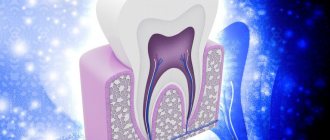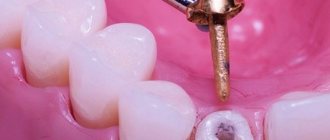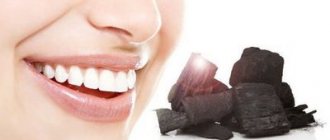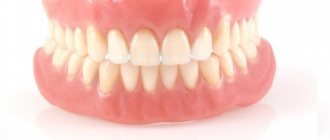The question of how to open a brace yourself worries many patients who are undergoing orthodontic treatment. Before opening the brace lock, you need to understand that only a professional orthodontist can do this correctly and as safely as possible. It is advisable to perform these manipulations in cases where there is a need to replace the arc or correct a problem that has arisen. Doctors do not recommend opening the lock at home. Quite often, when patients try to open the lock on their own at home using improvised objects, this leads to breakdown of the structure. In today's article we will talk about how to open a brace as carefully and safely as possible without the help of a doctor.
How to open the lock on braces
Before opening the lock on the braces, the patient must know what type of structure is installed on the dentition. You can unfasten the lock of ligature systems using special tools. All designs of various models are equipped with keys, which every orthodontist has. Dentists sometimes use a float or ligature pliers to open the appliance. At home, you can unfasten the lock using these same tools, if you have them at home.
How to open a brace at home? You need to act as carefully and accurately as possible. Otherwise, you can damage both the teeth and the device element. You don’t have to put in much effort at home if you need to unfasten a Daimon-type structure. The plates are equipped with clips, the fixation of which differs depending on the specific model. A separate key is provided for each. It must be installed in the hole and rotated 45 or 90 degrees. After such actions, you can remove or replace the wire that is necessary for correction.
Patients often wonder: how to open a brace? This can be done even at home, provided that you have a special key at hand. Before opening a brace at home using improvised means, you should think about whether you need to do this? After all, even a toothpick can seriously damage structural elements or teeth. If the brace was damaged during an unsuccessful attempt to open it, you should contact an orthodontist as soon as possible. A professional doctor knows how to open the braces correctly and safely. Therefore, if such a need arises, it is better to entrust the task to an orthodontist.
Why is it dangerous to remove braces early?
Early removal of braces is possible, but only for medical reasons. Dismantling is carried out in the following cases:
- incorrect installation of the system;
- allergic reaction caused by braces;
- lack of result and the need for surgery;
- achieving an intermediate result that suits the patient.
The teeth change their position immediately after the installation of the structure, so at the very beginning of treatment the patient may feel discomfort or even pain in the oral cavity. Adaptation lasts 5-15 days, so you need to be patient and not try to influence the staples, move them to the side or pick the locks with various objects. If the mechanism is damaged, it will have to be reinstalled.
In addition, removing braces early is dangerous to your health. Incomplete treatment can lead to:
- dysfunction of the mandibular joint;
- pathological abrasion of enamel;
- destruction of individual dental units.
The orthodontist may temporarily stop treatment and remove braces to eliminate a sudden problem, such as caries or gingivitis. After this, the staples are installed again.
The lock has opened: what to do?
We figured out how to open a brace at home. It is enough to have a key and carefully open the lock. But what should you do if the lock accidentally opened on its own? In this situation, it would be advisable to visit a dental clinic. But many people manage to latch the structure on their own. You need to carefully monitor the position of the arc and make sure that it remains inside the mount. To close the clip on the dental unit, you need to apply force and press it on both sides. When it comes to self-regulating systems, many of them are secured with a special latch. If a person has no idea how to open a brace at home, even if they have a key, it is better not to risk it and make an appointment with an orthodontist.
When are braces removed?
Braces are removed after the planned result is achieved, and the likelihood of relapse is minimal. How long the structures will have to be worn depends on the following factors:
- The complexity of the pathology. It is possible to change the position of several units in 6-12 months, but multiple anomalies have to be corrected within 1-3 years.
- Age. In childhood, the tissues are more pliable, and the teeth quickly take the position specified by braces. Adult patients need to prepare for longer treatment.
- Type of orthodontic braces. Metal and sapphire braces cope more effectively with malocclusion pathologies, ceramic braces work a little slower, and you have to wear plastic products the longest.
- Compliance with the rules of therapy. The patient needs to periodically visit the dentist to tighten the arch of the structure. It is also necessary to follow diet and hygiene rules. If a person does not follow the doctor’s recommendations, treatment becomes more complicated and delayed.
- Target. It is not always necessary to wear braces until the bite is completely corrected. In some cases, it is enough to eliminate the aesthetic defect. If deviations do not cause inconvenience, and the smile has become beautiful, the doctor may suggest removing braces earlier than planned.
You won’t be able to determine that the treatment has come to an end and it’s time to remove braces on your own. You will need to undergo an examination and take pictures of your jaws. After this, the doctor prescribes a time for removal of the structure. Dismantling is carried out in one procedure.
The bracket has come off: what to do?
Another common problem is the unsticking of system elements. In such a situation, you should also seek help from a doctor. If such an opportunity is not expected in the near future, you can act at home. You can either attach the plate to the tooth using special wax, or carefully remove the lock. Please note: metal models are durable, so they are much easier to glue than ceramic structures. Ceramics are quite fragile and can break during DIY repairs. If an element breaks, you will have to buy an orthodontic device again, which will be expensive. Peeling off often provokes non-compliance with the rules of wearing the system. To avoid problems with the structure during orthodontic treatment, you need to follow the rules and remember the limitations.
Can braces be removed by another orthodontist?
Any orthodontist can dismantle an orthodontic structure, but it is better to have this procedure done by the doctor who installed the braces. Firstly, he knows exactly all the nuances of the treatment process, and secondly, the cost of treatment, as a rule, includes the removal of the structure. Another clinic will have to pay for examination and dismantling of the system. You will also need to pay separately for fitting retainers. In any case, when going to another dentist, take your medical record, which describes the pathology and all stages of treatment.
How to properly brush teeth with braces?
To care for your teeth while wearing braces, you will need a whole range of products:
- A suitable toothpaste should be recommended by your dentist.
- Special orthodontic toothbrush.
- Mono-tuft toothbrush.
- Interdental brushes of different diameters.
- A special dental floss for caring for braces is superfloss.
- Mouthwash.
- And, preferably, an irrigator.
You need to brush your teeth thoroughly twice a day - morning and evening, consistently using all the products from the list above. With toothbrushes you need to make sweeping movements, first on the lateral sections of the dentition - from the outside and from the inside, and then in the front. Using dental brushes and floss, it is necessary to thoroughly clean the interdental spaces, areas under the arch and next to the braces. At the end of hygiene, you need to rinse your mouth with mouthwash or use an irrigator.
During orthodontic treatment, patients need to carry a special travel dental hygiene kit with them in order to always be able to get their teeth in order with braces. After each meal, remove all food debris from the braces system.
In addition to daily home hygiene, once every 4-6 months, patients with braces need to undergo a professional hygiene procedure in the clinic.
Immediately after fixing the braces system, the orthodontist will teach the patient how to properly care for their teeth during treatment.
Remember, it is not braces that spoil your teeth! It is poorly cleaned plaque that causes demineralization and then caries.
Do teeth with braces hurt a lot and what can you do about it?
Fixing braces is a painless procedure. But after the orthodontic archwire is installed in the braces, pressure will be placed on the teeth. Therefore, for several days after installation and each new arch replacement, the teeth may ache a little.
How much your teeth will hurt depends on the characteristics of your body and its pain threshold. According to statistics, 10% of patients’ teeth do not hurt at all, more than half report minor pain, and only 5% of brace wearers report severe pain.
In any case, the discomfort goes away after a few days, and the orthodontist will advise which painkiller is best to take if the pain greatly ruins your life.
So putting on braces is not painful, but rather a little unpleasant. But for the sake of the beauty of your smile and your own health, you can endure a little.
Damon Clear
Damon Clear are all-ceramic, self-ligating braces that are definitely suitable for those patients who want to correct their bite while maintaining the natural attractiveness of their smile. Daimon Clear is the most aesthetic system in the brand’s range of braces.
The system's production material is dental ceramics made from polycrystalline aluminum oxide. This unique material is durable and at the same time translucent, so Damon Clear braces will be almost invisible on tooth surfaces.
There are no metal elements in the design of Damon Clear braces; even the grooves and locks of the system are made of ceramics. Therefore, this model can be recommended for patients with allergies to metals and their alloys.
The plates of Damon Clear braces have a rounded, streamlined shape, which not only provides high aesthetics, but also eliminates the risk of injury to the oral mucosa and soft tissues.
The special type of ceramic from which Damon Clear bracket systems are made does not absorb pigments from food, odors, and is not subject to oxidation processes. Thanks to these properties of the braces material, they retain their attractive appearance throughout their entire service life.
Damon Clear braces are larger in size than metal systems. The increased dimensions of the structure are explained by the need to increase its strength, because ceramics in this indicator are noticeably inferior to stainless steel. Due to the rather large size of the structure, Damon Clear braces may not be suitable for patients with small teeth; they are not recommended for use on the lower jaw. But the orthodontists of our dentistry in St. Petersburg - “New Line Dent” can offer an effective solution in such a situation: for example, aesthetic Damon Clear can be placed on the upper jaw, which is clearly visible when smiling, and Damon Q made of stainless steel can be placed on the lower jaw.
Duration of treatment and frequency of dental visits
The exact answer to the question of how long you should use Damon braces actually depends on many factors. On average, it takes from one to three years to correct the dentition. The timing of treatment is influenced by age criteria, characteristics of bone tissue, the severity of pathological processes, anamnesis and the specific clinical situation. In adolescence, restoration of correct occlusion is faster due to the fact that the dental system is not yet fully formed. The movement of teeth under the influence of braces occurs more easily than in adult patients.
The schedule of visits to the dental clinic is compiled on an individual basis. During scheduled visits, the orthodontist evaluates the dynamics of treatment, the general condition of the patient and the appearance of the system. If necessary, he can carry out professional cleaning and sanitation of the oral cavity. After installing Damon braces, the frequency of inspections is once every one and a half to two months.
Please note that consolidating the final result may require additional time. After removing the brace system, the so-called retention period begins, during which retainers perform the function of a corrective device.
This design has a supportive therapeutic effect and prevents teeth from moving in the wrong direction. The duration of the rehabilitation stage is individual for each patient. In most cases, dentists recommend wearing retainers twice as long as braces.
What is orthodontic wax and how to use it?
Let's take a closer look at what orthodontic wax is and how to use it. The main thing is to stick it exactly on the area that causes friction. This can be done using a mirror, examining the mucous membrane and identifying problem areas. Then a small piece of orthodontic wax needs to be warmed in your hand, shaped into a ball and carefully glued onto the dried braces. You don't need to press it too hard. The wax should slightly increase the volume of the structure. Also make sure that the wax does not penetrate into the interdental spaces.
The wax pad should be removed before meals. Although orthodontic wax is completely safe, swallowing it is still not recommended. In order to close the problematic parts of the braces, you can also use beeswax and paraffin.
What can you eat with braces?
There are no big prohibitions on certain foods during orthodontic treatment, but it is better to adhere to the following rules:
- In the first days after installation and activation, while your teeth ache, it is better to eat soft and liquid food - porridge, puree soups, smoothies, yoghurts and curds. This will make it easier to get used to your new state.
- There is no need to eat sticky foods that can get stuck in the braces and damage them. And even if they don’t damage them, it’s difficult to clean them out later. Therefore, toffees, caramels, chewing gum, as well as cookies, baked goods, and other foods that become sticky when chewed are prohibited.
- Do not eat hard foods - crackers, nuts, pieces of meat, etc. — they can easily damage your braces. For the same reason, cut raw vegetables and fruits into small pieces.
- Don't forget that products such as tea, coffee, colored drinks, beets, blueberries, etc. may change the color of some types of braces and ligatures on them. And sitting in a cafe with a brace system full of, for example, red beets is not very aesthetically pleasing. So think about it.
- If your brace system has thermo-active orthodontic wires, then you cannot eat ice cream or drink ice water. The fact is that at ordinary temperatures a thermoactive arc can be given any shape. Then, under the influence of a person’s body temperature, it “remembers” the shape that was put into it during production and begins to work. And here you are with your ice cream...
Advantages and disadvantages
Damon Clear devices have many advantages that set them apart from other models:
- high comfort of treatment due to the unique shape of the product;
- the absence of ligatures allows for correction with minimal impact on the teeth, which reduces pain during treatment;
- this type of system requires fewer visits to the dentist to correct the arch and apparatus, which significantly saves money and time;
- the time of the correction procedure is only 10 – 15 minutes;
- the treatment period is 25% shorter than when using other systems;
- high aesthetics of the system;
- ease of care.
In addition, a significant advantage is the fact that the device can be installed in the presence of periodontal problems.
The disadvantage of this design is the cost, which is slightly, but still higher than similar systems.
New from the manufacturer: DAMON CLEAR 2 INSIGNIA braces
The key feature of DAMON CLEAR 2 INSIGNIA braces is that they are made individually for each patient. The transparent, aesthetic design is made using computer modeling technology and therefore is ideal for the patient, taking into account all the structural features of the jaws and teeth.
Computer modeling allows you to plan the course of bite correction as accurately as possible and avoid treatment errors that lead to recession and other negative consequences.
This new product is also distinguished by increased strength and reduced clearance of the lock in the arc area, which brings them closer in strength to metal precuts. The video demonstrates the operation of arc control. On the left is the old system, on the right is the new DAMON CLEAR 2
Medical indications and contraindications for installation
Orthodontists usually recommend using braces in cases where the patient has:
- pronounced deformation of the dentition;
- crowded teeth or large distances between them;
- presence of teeth extending beyond the row;
- slowing down or stopping the teething process;
- disproportionate development of the jaws;
- anomaly of the dental system;
- indications for implantation or prosthetics.
Among the contraindications, there are several reasons why a doctor may recommend refraining from installation:
- the presence of serious diseases that have a negative impact on the general condition of the body;
- serious disruptions in the functioning of the immune and circulatory systems;
- individual manifestations of allergic reactions;
- lack of oral hygiene;
- diagnosing diseases such as HIV, hepatitis, tuberculosis and oncological processes;
- the presence of certain mental disorders that represent an obstacle to quality orthodontic treatment;
- functional abnormalities in the functioning of the respiratory and cardiovascular systems;
- inflammatory processes of an acute and chronic nature (periodontitis, gingivitis);
- diseases with violation of the integrity of bone tissue (osteolysis, rickets, osteoporosis);
- absence of a large number of units in a row.
Distinctive characteristics of braces
To understand what Damon braces are, you need to understand the principle of operation of the self-ligating system. How does such a mechanism work? Each plate is equipped with a special lock that holds the arc, but at the same time allows it to move freely, thereby minimizing the friction force. In such designs there are no elastic ligatures, so the system independently determines the tension force of the arch, which is optimal for uniform correction of the position of the teeth in the row. To understand what such systems look like, take a look at the photo below.
Photo of a patient before and after treatment using the Damon system
The main distinctive characteristics of the models presented in the Damon line include the following features:
- good aesthetics: the reduced size of the plates makes it possible to achieve fairly high aesthetics. In the case of Damon Clear models, the brackets completely adapt to the natural color of the enamel and become almost invisible on the teeth,
- precise and uniform pressure: due to the fact that the systems are self-ligating, they provide a targeted effect on the teeth, promoting their gradual movement in the desired direction,
- accelerated rates of treatment: according to the manufacturer, Damon braces can reduce treatment time by 20-25%,
- no need for frequent visits to a specialist: the ligature-free design independently regulates the force of the arc pressure, so one visit to a specialist in a couple of months is enough. But closer to the end of treatment, the doctor can fix the ligatures in order to obtain the maximum effect. How many wires are changed in the system when switching it to manual ligation mode? The answer to this question directly depends on the specific clinical situation. In this case, it is necessary to visit a specialist every month.
“My teeth are naturally crooked, which has embarrassed me since childhood. But, as a teenager, I really didn’t want to walk around with iron teeth, and without them there were enough complexes. And only at the age of 23 did I finally mature. My orthodontist recommended the Damon system - regular iron braces, but without rubber bands. I spent a little over a year and a half with them. Now all my teeth are perfectly straight, which I am immensely happy about. As for the treatment process itself, there was pain and discomfort only in the first month. Then I completely got used to it, and in the end I stopped noticing them altogether.”
Irina, Ekaterinburg, review from flamp.ru
- patented locking mechanism: each plate has a small lock with a snap-on lid, thanks to which the arc remains in the grooves,
- precise placement of brackets on the teeth: the special base of the plates allows them to adapt to the shape of the teeth, thereby avoiding the formation of gaps between the brackets and the enamel,
- resistance to coloring pigments: braces retain their original color throughout the entire course of treatment,
- ease of care: due to the fact that the system is devoid of ligatures, cleaning braces becomes easier and takes much less time.
Damon-Q (Damon Q)
Damon-Q braces are self-ligating metal braces in which the system locks and the fixing element are combined into a single structure. The arch is fixed in the grooves of the braces with a special clamp and therefore can move freely in them: due to this, friction and the degree of pressure on the teeth are reduced. The unique locking mechanism simplifies and facilitates the process of replacing the power arc.
The plates of Damon-Q braces are compact in size: they are much smaller than braces of standard orthodontic designs from other manufacturers. The reduced size of the plates ensures quick adaptation to the system; patients get used to it in just a couple of days. In addition, miniature plates eliminate discomfort when wearing braces on your teeth.
Damon-Q braces are made from medical steel grade 17-4 - a material that is not only durable, but hypoallergenic. A significant advantage of braces from the Damon-Q line is their versatility. They can be used in different clinical situations and for patients of different age groups: adults and children over 12 years old.
How to wear orthodontic traction bands - elastics?
Orthodontic rods - elastics - are special latex “rubber bands” that are placed on the hooks of the braces system to tighten the jaws together. They greatly increase the effectiveness of braces treatment. Properly selected and worn elastics do not interfere with speaking. The main rule of wearing pull-ups is regularity.
The time to start wearing elastics, their type and the pattern according to which the rods are put on the brace system is prescribed ONLY by the orthodontist. Wearing elastics on your own can only cause harm. Also, the orthodontist puts orthodontic rods on the patient’s brace system for the first time and teaches him to do it independently. In order not to forget the location of the rods, it is convenient to photograph the diagram and then carefully repeat it - it is not at all difficult.
Examples of work “Before” and “After”
Correction of bite with Invisalign aligners
Problem: the patient is not satisfied with the aesthetics of the teeth in the front row, narrowing of the upper and lower jaws, after examination, caries and the presence of dental deposits were revealed Work: the Invisalign method was chosen for treatment (dental guards on both jaws), comprehensive cleaning of plaque and stone, caries treatment Time: 36 weeks Cost: treatment with invisalign aligners - 160,000 rubles.
Overbite correction with Aspire ceramic braces
Problem: the patient complained of gaps between teeth.
Overbite correction with Damon Clear braces
Problem: a 27-year-old patient complained of severe crooked teeth in both jaws.
Braces Damon 3
Damon 3 braces belong to the combined bracket systems: the bracket plates are made of durable plastic, additionally reinforced with ceramic elements, the grooves and bracket locks are made of stainless steel. These design features of Damon 3 allow you to preserve the aesthetics of your smile during bite correction and ensure high treatment efficiency.
Damon 3 braces have smooth, smoothed contours, eliminating injury to the soft tissues of the mouth and providing comfort when wearing the structure on the teeth. The color of the plates and the color of the arch are selected exactly to match the enamel of the patient’s teeth.
Damon 3 braces can be recommended to those patients for whom aesthetics during bite correction remains fundamental, but who do not have the financial ability to install lingual invisible braces or expensive systems made of artificial sapphire.











